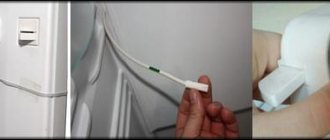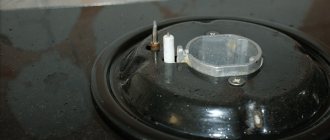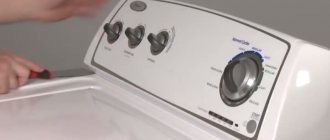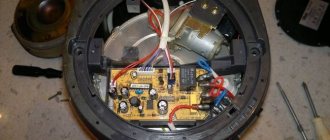Television, even with the development of technology, occupies a large place in human life. Modern wide-format models allow you to feel like you are in a movie theater without leaving your own walls and a soft sofa. It is TV that still remains the main source of news about what is happening in the world and the country. Therefore, any breakdown spoils the mood of its owner. A faulty power supply is a small problem, but the most common of all. A natural question arises: where to find a repairman and whether it is necessary to take the equipment to a service center. It’s easy to solve if a breakdown occurred and was noticed during the day, but finding a specialist at night is several times more difficult. You can try to fix the problem yourself, because this option is possible in some cases.
Design and principle of operation
switching power supply board is often made in the form of a separate electronic module, which is a characteristic feature of TVs with a small screen diagonal. In larger models, it is integrated into the receiver chassis and is located inside its structure (see photo below).
The PSU board includes the following required components:
- Pulse transformer.
- Mains power filter assembled using chokes and capacitors.
- Standby and operating mode units.
- Overload protection module.
- Cooling elements (radiators).
The principle of operation of the power supply is to bring the mains voltage to a form that satisfies the power supply requirements of the main electronic components of the TV (including its matrix).
Additional information: The magnitude and shape of the supply potentials must correspond to the operating voltages and their diagrams given in special tables.
Sometimes they are indicated directly on the electrical diagram of a particular device.
What it is?
In the most general sense, the power supply is a source of electricity that supplies the TV with the necessary current . This module allows you to convert the mains voltage to the values necessary for the full functioning of the equipment. As a rule, a power supply is included in antennas with an amplifier in order to improve signal reception.
Power supplies are universal devices; they can be installed in other devices: to improve the signal quality of cellular, satellite communications and even the Internet . The power supply is indispensable in a situation where a Wi-Fi adapter is used; by the way, it is also one of the types of antennas. Simply put, wherever radio waves are used and there is a receiving antenna, a power supply is needed.
But we will consider only those varieties that are required for the smooth operation of television equipment.
Please note: the relevance of installing and maintaining the power supply is directly related to the fact that in its absence, repairing it can be very costly or even impossible.
The television power supply performs three main functions:
- converting the energy of current supply into equipment;
- protection against supply voltage interference;
- maintaining the required voltage level inside the TV itself.
The most widespread are modern systems operating from standard 220 W networks. Such elements can be built into a single antenna structure or located separately when the connection is made through a port.
When it comes to built-in models, a transformerless circuit is usually used. In this case, energy conversion is carried out due to pulse width modulation. Such power supplies are plugged into the most ordinary outlet, their calculated power is 10 W. This parameter is quite sufficient to provide power to the antenna. Such elements are quite compact and do not take up much space, but in the event of a malfunction they immediately lead to the failure of the entire signal reception system.
Therefore, it may be more practical to purchase external devices . They are focused on the fact that in the event of a power supply failure, some signal will still be preserved, although, of course, it will not be good. In any case, another advantage of external power supplies is that they can be quickly and easily replaced if necessary.
The operating scheme is based on a transformer . In this case, the output voltage of the power supply is stabilized in a parabolic manner; the typical parameters for the output voltage are 24, as well as 18, 12 and 5 W. More precise figures are determined depending on the technical and operational parameters of the antenna.
Where to buy a power supply for a monitor with delivery?
On our website you can find adapters for displays from all well-known manufacturers. We offer high-quality accessories that have been certified and approved for sale in the Russian Federation. When used correctly, our adapters will not harm the equipment or its owner.
It is important for us to provide the client with reliable products, so we have established direct cooperation with manufacturers and do not use the services of intermediaries. This allows us to offer universal power supplies for monitors at low prices. Also, this scheme of work allows you to protect the buyer from counterfeits.
We deliver orders all over Russia, and it doesn’t matter to us how many units of goods you want to purchase. Our clients include thousands of retail buyers and wholesalers; we take an individual approach to each of them and always meet our needs.
By region, shipping is carried out via Russian Post, EMS and transport companies within up to 12 days (depending on the distance and the chosen organization). Delivery to a specific address or to a pick-up point is possible.
In Moscow, the client can receive the order the next day after confirmation of the application or payment. Delivery is made through courier services; if desired, the client can independently pick up the order from our warehouse.
We have been selling online for many years and are ready to quickly solve any problems. Cooperating with us is simple, convenient and profitable!
Featured Posts
mailman007 1
- New guy
- Members
- 1
- 5 publications
Hello comrades.
I have a problem. My TV LG 42LN541V – ZC has worked well.
The problem is this: when you turn it on, the backlight lights up for a split second. Then it fades away smoothly within a second. There is complete silence for about 5 seconds, then it lights up again and goes out smoothly. It's like this all the time. There is an image even without the backlight, there is sound, the TV works fine, but there is a problem with the backlight.
Having disassembled the case, I found the power supply. Having measured the voltage on it, with and without a load, jumps in the region of 150-120 volts are observed.
I have a multimeter UK - 830 LN, my hands don’t seem to be very crooked, a soldering station, a clear head, I can’t read diagrams well and I really don’t want to go to the service center.
What do you advise?
Attached is the power supply diagram. I have a block LGP42-13PL1
lg_eax64905301_lgp42_13pl1_led_tv_sch-spaces.r.pdf
Modified on January 21, 2021 by mailman007
Adver 220
- Old timer
- Members
- 220
- 72 publications
KRAB 7 402
- Old timer
- Members
- 7 402
- 36,669 publications
16 minutes ago, mailman007 said:
I really don’t want to go to the service.What do you advise?
As a person with more than a quarter of a century of experience in repairs, I’ll tell you one thing - it’s not “hot”, but it will have to be! If you don’t have experience in repairing modern SMPS containing PFCs (PFC), just don’t bother – it will be cheaper in the end. And judging by
18 minutes ago, mailman007 said:
I'm bad at reading diagrams
– especially don’t get into it. No one will lead you by the hand, but you can find about 40-50 USD. to repair it, considering how much you bought it for, you can!
I looked at the diagram - there is no cash register there - it’s already easier... but you don’t have a device for checking the “thongs”, you won’t open the “mattress”, and if you do... it’s a pity for TV... so you won’t be able to check reliably and replace the SD either!
Adver 220
- Old timer
- Members
- 220
- 72 publications
mailman007 1
- New guy
- Members
- 1
- 5 publications
18 minutes ago, KRAB said:
as a person with more than a quarter of a century of experience in repairs, I’ll tell you one thing - it’s not “hot”, but you have to! If you don’t have experience in repairing modern SMPS containing PFCs (PFC), just don’t bother – it will be cheaper in the end. And judging by– especially don’t get into it. No one will lead you by the hand, but you can find about 40-50 USD. to repair it, considering how much you bought it for, you can!
I looked at the diagram - there is no cash register there - it’s already easier... but you don’t have a device for checking the “thongs”, you won’t open the “mattress”, and if you do... it’s a pity for TV... so you won’t be able to check reliably and replace the SD either!
At first I laughed heartily, but when I opened your “mattress” all the backlight strips were shining properly. The problem is still in the block, and it seems to me that it is in the inverter. I just can’t figure out how to check and where to start.
Adver 220
- Old timer
- Members
- 356
- 72 publications
KRAB 7 402
- Old timer
- Members
- 7 402
- 36,669 publications
2 minutes ago, mailman007 said:
all the backlight strips are shining properly
at the moment of switching on?
Adver 220
- Old timer
- Members
- 224
- 74 publications
Degson spring terminal blocks - high quality connections at the best price!
Degson's PCB Mount Spring Terminal Blocks provide a simple, reliable connection that makes it easy to meet a variety of applications with a wide range of options. Degson terminal blocks are available in two designs (end contact and clamp cage), have different conductor entry directions (45°, 90°, 180°) and have a wide range of cross sections (0.2...2.5 mm2).
More details
mailman007 1
- New guy
- Members
- 1
- 5 publications
Just now, KRAB said:
at the moment of switching on?
No. I supplied 30 volts to each tape, all the diobs work properly, however, as far as I understand, I haven’t checked the driver (or controller) of the backlight itself, it’s difficult to do this when the TV is working, the cord from it is very short, and I don’t want to cut it
Adver 220
- Old timer
- Members
- 220
- 52 publications
IMXO 2 042
- system error
- Moderators
- 2 042
- 11,540 publications
2 minutes ago, mailman007 said:
At first I laughed heartily, but when I opened your “mattress” all the backlight strips shine properly.
that's why it doesn't work...
mailman007 1
- New guy
- Members
- 1
- 5 publications
10 minutes ago, IMXO said:
that's why it doesn't work....
but, it didn’t work even before opening) no, well, I’m serious, I want to do it, and get some experience))
Adver 220
- Old timer
- Members
- 220
- 72 publications
IMXO 2 042
- system error
- Moderators
- 2 042
- 11,540 publications
The LEDs are fried, the voltage drop is greater = the voltage protection is working...
mailman007 1
- New guy
- Members
- 1
- 5 publications
Just now, IMXO said:
the LEDs are fried, the voltage drop is greater = the voltage protection is working...
I completely turn off the power to the backlight, the effect is the same. It's not because of her
IMXO 2 042
- system error
- Moderators
- 2 042
- 11,540 publications
man, you didn’t even understand what they were writing to you, take it to the service center, it will be cheaper...
P O P U L A R N O E:
- How to properly replace a car air conditioning compressor?
...or flushing the air conditioning system
Good day, dear readers! I'll tell you one case. Once a car came to our car repair shop to replace the air conditioning compressor.
Checked the pressure during operation. It was discovered that the compressor was faulty.
They changed it quickly. We evacuated the system and refilled it. The new compressor worked perfectly.
Read more…
DIY wood products
Interesting and useful products can be made from wood! Once upon a time, not very long ago, I was very interested in work related to wood processing and the manufacture of wood products. And this was more related to everyday needs than to interest.
Read more…
Flower vase from an old chandelier
How to easily make a beautiful flower vase with your own hands?
If you have an old chandelier, do not rush to throw it away. You can decorate a vase with its glass elements.
I had the remains of an old chandelier lying around, so I decided to make a flower vase...
Read more…
Popularity: 28,727 views.
Typical faults and their identification
typical power supply using the example of a TV with an LCD screen of the ViewSonic N3260W brand. Their external manifestations are expressed in the following deviations from the normal operating modes of the reproducing device:
- When I press the "Network" button, the TV does not turn on at all.
- The indicator lights up, but the TV does not switch from standby to operating mode.
- The image appears only after some time.
- It is possible to turn on the TV only after a few attempts, after which normal image and sound appear.
The first thing the inspection begins when most of these faults are detected is a thorough visual inspection of the power supply board with the device completely disconnected from the network. If nothing suspicious is found, you should move on to a more detailed analysis of the reasons for their occurrence. To do this, you will need to remove the power module from the TV body, first disconnecting all connectors.
Then it is necessary to discharge the high-voltage filter capacitor of the power circuits, the residual voltage on which is dangerous for humans. In the power units of most TV models, including this one, the most common causes of malfunction are:
- Failure of electrolytes in secondary supply circuits.
- Poor quality soldering of individual components of the board (chokes and semiconductor elements, in particular).
- Burnout of power (key) transistors.
- Broken or lost contact in the supply connectors.
Please note: You can make sure that the electrolytes have aged and failed by their swollen cap (photo above).
The consequences of poor voltage filtration due to their malfunction are very different. They manifest themselves either in the complete loss of functionality of the power supply unit, or in associated damage to the inverter elements. They often lead to a software failure in the motherboard memory chips and the need to update it.
Other faults are also detected visually. When transistors burn out, for example, in the area of their legs, a black residue of burning can be clearly distinguished. Periodic loss of contact in the connectors is determined by its restoration when slightly swayed from side to side. To carry out such a test, you will need a tester turned on in the “Ring” mode. In other cases, malfunctions are detected by the loss of the required voltages at the output (or their deviation from the norm).
Basic power supply faults
Any malfunction of the TV's power supply will affect the performance of the TV. And the most frequent breakdowns of TVs are associated with this part. There may be several reasons for this:
- Incorrect operating conditions;
- Violations of climatic regimes;
- Unfair assembly of equipment;
- Amateurish intervention.
The first thing this technique doesn’t like is sudden changes in temperature and humidity. If you bought a TV in winter and brought it into a radically warm room, you cannot immediately plug it into the network and start watching television channels. Condensation can form inside the equipment, which can lead to failure of the most important components of the equipment.
Many breakdowns occur in cheap TVs due to the manufacturer's savings on the quality of parts, microcircuits and assembly. Also, very often TVs break down after unprofessional repairs: they were able to take them apart, but they couldn’t put everything back together correctly.
To afford to independently repair very expensive equipment, you must have basic technical knowledge, practical skills and the necessary set of tools. Don't skimp on repairs unless you're experienced, as you can easily turn a simple breakdown (like bad solder joints) into an expensive repair.
Most often, power supplies fail for the following reasons:
- The safety element has burned out (after a thunderstorm, for example);
- Failure of key components;
- There is not enough voltage to start the TV;
- Transistor burned out;
- Incorrect output voltage in circuits.
But not everything is as scary as it looks at first glance. You can find the breakdown yourself if you follow a clear search algorithm.
Manifestation of PSU malfunction
Unlike other TV components, any failure of the power supply immediately affects the performance of the TV as a whole. This means that after turning on the TV to the network, the activity indicator will not even light up, not to mention the output of sound, pictures or other signs of life. The breakdown may be as follows:
- the TV does not turn on and the LED does not light up;
- the device does not function due to protection in the power supply, which is usually accompanied by a whistling noise from the pulse transformer. This manifestation may also indicate the necessary repair of the LED backlight in the TV;
- The output voltage is too low or too high from the power supply.
If the device can turn on and simply exhibits some kind of defect in its operation, then this is most likely caused by another component of the TV, and not the power supply. However, there are also a number of exceptions in which the problem is still associated with the power supply:
- the device does not turn on, although the standby LED is on;
- the image appears some time after the sound;
- To get a normal picture and sound, the TV must be turned on and off several times.
Separately, it is also worth mentioning possible breakdowns of other components of the TV, which are not caused by problems with the power supply, but directly affect its operation. These include power supply units, feedback circuits, power supply loads, and so on.
TV PSU faults and repairs
The primary power supply circuit of televisions is built according to standard pulse circuits. Therefore, malfunctions are typical for switching power supplies. Accordingly, before repair it is necessary to make diagnostics, which is done when repairing a pulse unit. But this does not mean that repairing a TV power supply is as simple as a separate power supply. Because the secondary circuits are different.
Typically, TVs have three circuits on one board:
- power unit
- Inverters
- PFC power factor correction circuit
Modern TVs use LED backlighting instead of lamp backlighting. And instead of inverters there is an LED backlight driver.
Firstly, in the power supply, the culprits of the malfunction are often low-quality electrolytic capacitors. For example, on a Samsung TV, repairing the power supply consisted of replacing 4 capacitors.
In particular, faulty capacitors swelled. But this is not at all necessary. Because a faulty capacitor can look completely normal.
By the way, a feature of repairing power supplies in TVs is that after repair the TV may not work. Because there are more elements on the board. For example, on a Samsung TV there was a short circuit due to the key transistors in each of the inverters (circled in the photo in blue). The fuses also burned out (in the red oval).
As a result, we still had to replace 8 transistors and 4 fuses. The more multiple faults, the higher the repair cost. For example, this TV repair consisted of replacing 4 capacitors, 8 transistors and 4 fuses. The repair price was 3,500 rubles. But the repair of the power supply itself cost 1,500 rubles.
Secondly, the power active elements burn. For example, diodes in both the primary and secondary circuits.
And of course the regulator chip and transformers fail. The fuse in the primary circuit never blows for nothing. Usually it burns out if there is a short circuit in transistors, capacitors, a diode bridge, etc. Therefore, immediately cross out the most popular option “there’s probably just a blown fuse.”
Moreover, modern TVs use cost-effective active PFC (power factor correction) circuits. They make repairs much more difficult, but decent TVs cannot be made without them. Of course, complex circuits break down more often and are harder to repair.
Malfunctions appear periodically.
In this case, you should proceed as follows:
- check the soldering of the power supply elements for ring cracks;
- check the elements in the places of greatest heating on the board, identifying them by blackening.
- If a malfunction occurs when the TV is warming up, you can localize the faulty element either by cooling (cotton wool moistened with acetone or alcohol), or to speed up the appearance of the malfunction, provoke it by heating one or another element with a soldering iron.
Diagnosis of the TV power supply before repair
To perform a competent diagnosis of a power supply failure, you need to carry out several step-by-step actions.
Disassembling the TV
Determining the cause of the problem begins with disassembling the device. To do this, unscrew the screws from the back cover of the TV to open access to the power side.
In different TV models, power supplies are located differently, so it is not always possible to immediately see this element after removing the cover. If this is your case, then access to the power supply is most likely blocked by a protective metal casing.
In some TV models, additional protection may be installed specifically for the power supply. In this regard, you will have to go through several stages of unscrewing the screws that secure the desired part.
Familiarization with the power supply device
To take further actions, you need to clearly understand what the components of the TV power supply look like. All modern models have not one power supply, but several. They are usually located in one place - the board. This board is easy to distinguish from others: in addition to capacitors and other components, it contains 3 black and yellow transformers.
The TV power supply consists of the following components:
- Standby power supply . Its main function is to keep the TV in standby mode and await subsequent commands. A glowing LED indicator indicates that you are in this mode. For normal operation there must be a voltage of 5V, the supply of which to the TV is provided by the duty element.
- Inverter block . The main function is to provide power to the processor. If this function is violated, when you try to turn on the TV, an instant transition to sleep mode is observed. This occurs as a result of the fact that the processor, without receiving confirmation of functionality from the inverter, stops activating further actions and returns to standby mode.
- PFC block . The main task of this component is to correct the power factor, which can be reactive or active. The first is necessary for the operation of the TV, at the same time it can significantly increase electricity consumption and affects the rapid wear of capacitors, which negatively affects the service life of the power supply as a whole. Active power carries out a useful action, and reactive power only transfers to the load from the generator and again to the generator.
Important information about power supplies:
The structure of the TV power supply and its main components is described in this video:
Troubleshooting
After familiarizing yourself with the components of the device, proceed to diagnose it. Using a tester, ring the output of the standby power supply - the result should be 5V. If the voltage is less than this indicator or is completely absent, the problem is most likely failed capacitors. To determine this, a simple inspection of these parts is enough - they will be convex.
The most vulnerable components of TV power supplies include filter capacitors, which lose their nominal properties faster than others. However, the damaged element does not always have visible damage. Poor-quality filtering leads to inoperability of the power supply, failure of the inverter, and software failures of the microcircuits on the board.
If the capacitors are OK, check the fuse. For this purpose, a ring is used, which will reveal the presence or absence of a short circuit.
You should also test the board from the back side, for which you must first remove the element from the frame. Check the resistors for the following deviations:
- darkening;
- cracks;
- poor soldering of leads;
- gaps between tracks.
All this can be tested visually, and then a decision can be made on how to solve the problem. If the inspection shows nothing, check the resistors with a multimeter. A fault will be indicated by zero resistance.
Analysis and determination of the problem
The power supply is often integrated into the design of the TV. You need to remove the back cover secured with screws. The next step depends on the specific TV model. If the block is not immediately visible, then the part is hidden behind a protective casing - you just need to unscrew more screws.
What does a power supply unit and its components look like?
The appearance of the power supply, located on the common board, is easy to distinguish from the rest. It is gray in color, looks like a square box, and is usually located on the edge of the power board. Capacitors and other components have a different shape. But they can easily be confused with transformers - they are also rectangular in shape, but painted yellow.
BP components:
- Standby power supply (standby indicator is on, 5V voltage is consumed). In other words, if it is broken, the indicator on the TV panel will not light up.
- Inverter - turns off the receiver immediately after turning it on. It is responsible for power supply, so if it breaks down it returns to standby mode.
- Capacitors - the problem is identified by swelling.
These breakdowns can be eliminated using power factor correction. Usually this diagnosis is carried out at a service center, but in general you can try to do it at home. In addition, such malfunctions are easy to fix - you need to purchase the necessary part and replace it using a blowtorch.
IMPORTANT: Be sure to take a photo of the power board with you to make the right purchase. Despite the fact that the blocks are almost identical, you need to be careful with the characteristics of the new parts.
Procedure for diagnosing and troubleshooting
The general procedure for diagnosing and eliminating detected faults comes down to the following sequence of repair operations:
- All capacitors whose appearance causes at least some suspicion must be replaced immediately.
- If the operation of the standby mode unit malfunctions, you should check the 5 Volt voltage on the controlled zener diode.
- If at the output of this unit there is no voltage on the filter capacitors or its value is greatly underestimated, this means that the operating mode is disrupted.
- To restore it, you will need to make sure that all linear elements of the circuit are in working order.
Additional information: Their performance is checked using the same tester without completely desoldering the unit from the board.
To do this, it is enough to unsolder only one contact of the “suspicious” resistor or capacitor. Identified burnt elements are completely removed from the board and replaced with new ones. If you find poor-quality soldering, you should tin the area with flux, and then make sure that the contact leg is securely fastened in the fixation area.
The restoration of the operation of the standby circuit is indicated by the appearance of a voltage of 5 Volts, as well as the lighting of the red LED on the front panel of the TV (photo above).
With each subsequent replacement of other “suspicious” elements, you should immediately check the changes that have occurred at the power supply output. The restoration of the operating mode function, for example, is judged by the TV turning on normally and the appearance of an image and sound on its screen.
In conclusion of the review, we note that identifying and troubleshooting switching power supplies included in modern television receivers is not an easy procedure at all. It requires special measuring equipment and some skills in repairing electronic equipment. If you find it difficult to independently diagnose the cause of a TV failure, it is best to invite a professional technician. With the current, relatively low cost of repairing television equipment, this will save time and not waste your energy.
Our groups on VKontakte and Odnoklassniki
Visit the cool Shahan TV channel
How to check for serviceability in practice?
In general, external diagnostics of possible malfunctions and breakdowns of the power supply is as follows.
If the appearance of the capacitors causes you any suspicion, then they must be immediately removed and replaced.
If you notice interruptions in the operation of the standby mode, you need to immediately check the voltage on the controlled zener diode. If there is no voltage at the output of this node or it is too low, therefore, the operating mode is disrupted.
In order to restore the functionality of the element, it is necessary to verify the functionality of all other parts of the circuit. To do this, you should unsolder one contact of the suspicious capacitor or resistor, remove all burnt elements completely and immediately replace them with new ones. If you see an area of poor-quality soldering, this area needs to be tinned with flux, and then make sure that the contacts are firmly fixed in the fastening area.
The restoration of the power supply circuit and the return to standby mode will be indicated by the appearance of a voltage of 5 V, as well as the blinking of the red light indicator on the front panel of the TV.
Please note that whenever you replace other suspicious elements, you must immediately check whether changes have occurred at the output of the power supply.
The fact that the functionality of the equipment has been returned can be judged by the TV turning on normally and the receipt of high-quality audio and video.
Algorithm for finding a breakdown and repairing it
Repairing televisions and other household and industrial equipment can be profitable and cost-effective, but only if you have a minimum of technical literacy and are familiar with all relevant safety precautions. Not every amateur can repair a power supply. This is a very difficult and unsafe activity.
But if you still feel confident and want to understand the reasons why your TV is not working, in particular, check its power supply, we will suggest you perform the following sequence of actions:
- Unplug the TV and check the socket itself: the problem may be an unstable network voltage or a malfunction of the socket itself (or extension cord).
- Discharge the high-voltage capacitor on the board so that there is no short circuit in the future (you can simply short-circuit it with an insulating screwdriver, a tester, or hold a light bulb to it for a couple of seconds).
- If everything is fine with the power supply in the system, then the next step is to dial the standby power supply, in which, as was written earlier, the voltage should be maintained at 5 volts. If less, you will need to check the capacitors.
- Now check the fuse - often due to a temporary overload or due to a short circuit in the mains voltage circuits, this part may simply burn out.
- Now remove the TV case and remove the motherboard.
The actual cause of fuse failure can be power surges, sudden shutdowns, lightning strikes or random power failure. Important! You can only replace a blown fuse with a part of the same rating recommended by the manufacturer of the electronic device!
After this, place the board on a flat surface and conduct a visual inspection:
- Check the board itself for ring cracks;
- Using a special voltage measuring device (tester), check each resistor, transistor, electrolytic capacitor, diode;
- Carefully inspect all soldering areas, the continuity of etched tracks, whether there are breakdowns, breaks, etc.
If you notice a darkened or cracked resistor, it will need to be replaced. The resistance of these elements with values in the range from 0 to ∞ is also a sign of their inoperability. If there are capacitors on the board with a swollen top cover, they will also have to be replaced.
The operation of silicon diodes can be checked in two ways:
- Unsolder the board and check the voltage with a tester (in mode with a limit of 20 kOhm): in the forward direction the value should be 3-6 kOhm, in the reverse direction – ∞;
- The soldered diodes are checked with a multimeter in the voltage drop measurement mode - the value should be up to 0.7 V (if the voltage is 0 or close to that, then the element will still have to be unsoldered and checked using the first method).
Bipolar transistors need to be checked twice: both in the forward and reverse directions.
To check the supply voltage of a switching power supply, do the following:
- Take a circuit and 2 100-watt light bulbs.
- Determine where the horizontal scan output stage is located.
- Unplug it and plug in a light bulb instead.
- Find the power filter capacitor in the secondary circuits and connect a second light bulb to it, which will create a load simulation.
If the light comes on, this indicates that there are problems in the power supply: in the input circuits, rectifier, network, power capacitor, etc. But if the light comes on, goes out, and then lights up very poorly, then the power supply is normal. And the diagram will be needed in order to determine exactly where the gap formed.
If the power is turned off and the fuse has not blown, then most likely there is a faulty starting circuit (open starting resistors), open fusible resistors (due to short semiconductors), faulty controller components.
Diagnosing problems in switching power supplies is sometimes complicated by the interdependence of components that must function properly in order for any part of the power supply to perform its part of the operating process.
Depending on the design, an SMPS may or may not be overload protected: one model may fail catastrophically under heavy load, even if there is a short circuit protection fuse. In another power supply, communication devices (often 800 V transistors) may fail.
In addition, such equipment may malfunction when power is restored after a power outage. This moment is very tense: any power surge is undesirable. (Some designs take this into account and limit the turn-on jump).
However, the cause of many problems is immediately obvious and has simple fixes - the weakest link in their composition is a blown transistor chopper or a dry main filter capacitor. Don't assume that all power supply issues will always be complicated and confusing. In most cases no.
Power supply in a CRT TV
Do-it-yourself TV repair with a picture tube, for example, such as: Rubin, Horizon, Sharp 2002sc, LG TVs, as well as repair of the Vityaz TV, begins with checking the power supply for functionality (this is done if the unit does not turn on). It is checked using a 220 V incandescent light bulb with a power of 60-100 W. But before that, be sure to disconnect the load, namely the horizontal output stage (SR) - connect a lamp instead. The CP voltage ranges from 110 to 150 V, depending on the size of the kinescope. It is necessary to find the CP filter capacitor in the secondary circuit (its values can be from 47 to 220 µF and 160 - 200 V), located behind the CP power rectifier.
To simulate the load, you need to connect a lamp in parallel to it. To remove the load, for example, in the common Sharp 2002sc model, it is necessary to find and unsolder the inductor (located after the capacitor), the fuse and the limiting resistance through which the CP cascade receives power.
Now you need to connect power to the power supply and measure the voltage under load. The voltage should be from 110 to 130 V if the kinescope has a diagonal of 21 to 25 inches (as in the 2002sc model). With a diagonal of 25-29 inches - 130-150 V, respectively. If the values are too high, then checking the feedback circuit and the power supply circuit (primary) will be required.
It should be taken into account that electrolytes dry out and lose capacity during prolonged operation, which, in turn, affects the stability of the module and contributes to an increase in voltage.
If the voltage is underestimated, it is necessary to test the secondary circuits to eliminate leaks and short circuits. Then the CP power protection diodes and vertical scan power diodes are checked. If you are convinced that the power supply is working, then you need to disconnect the lamp and solder all the parts back. Such a check can also be useful when repairing a Philips TV yourself.
Troubleshooting
First of all, it is necessary to discharge the input capacitors. If this is not done, then during the repair process there may be a short circuit or other problems that will lead to more serious damage. To discharge, you can use a low-resistance resistor, a tester or a regular light bulb, brought to the contacts for a few seconds. After this, you can unsolder the damaged capacitors and replace them with working ones with the same power.
Important! Any repair of a power supply is associated with a number of risks. If you act carelessly, you can cause even greater harm to the TV or even your own health. If you have any doubts about your own abilities, you should trust the repair procedure to an experienced technician.
A video lesson from a master will tell you in detail about the entire process of repairing a power supply:
Main reasons
Failure of the power supply is one of the most common breakdowns of modern LED TVs. The cause of this malfunction can be caused by many factors, but among them there are 4 main ones:
- Unstable voltage. If the voltage in the outlet constantly “jumps”, then it can not only worsen the performance of the TV, but also lead to wear and tear of its components.
- Short circuit. Causes burnout of the power supply or other components of the TV.
- Burnt out mains fuse. In this case, the standby indicator will not light up.
- Capacitors wear out over time. A very common problem that does not depend on external factors. Worn capacitors can be identified by their swelling.











